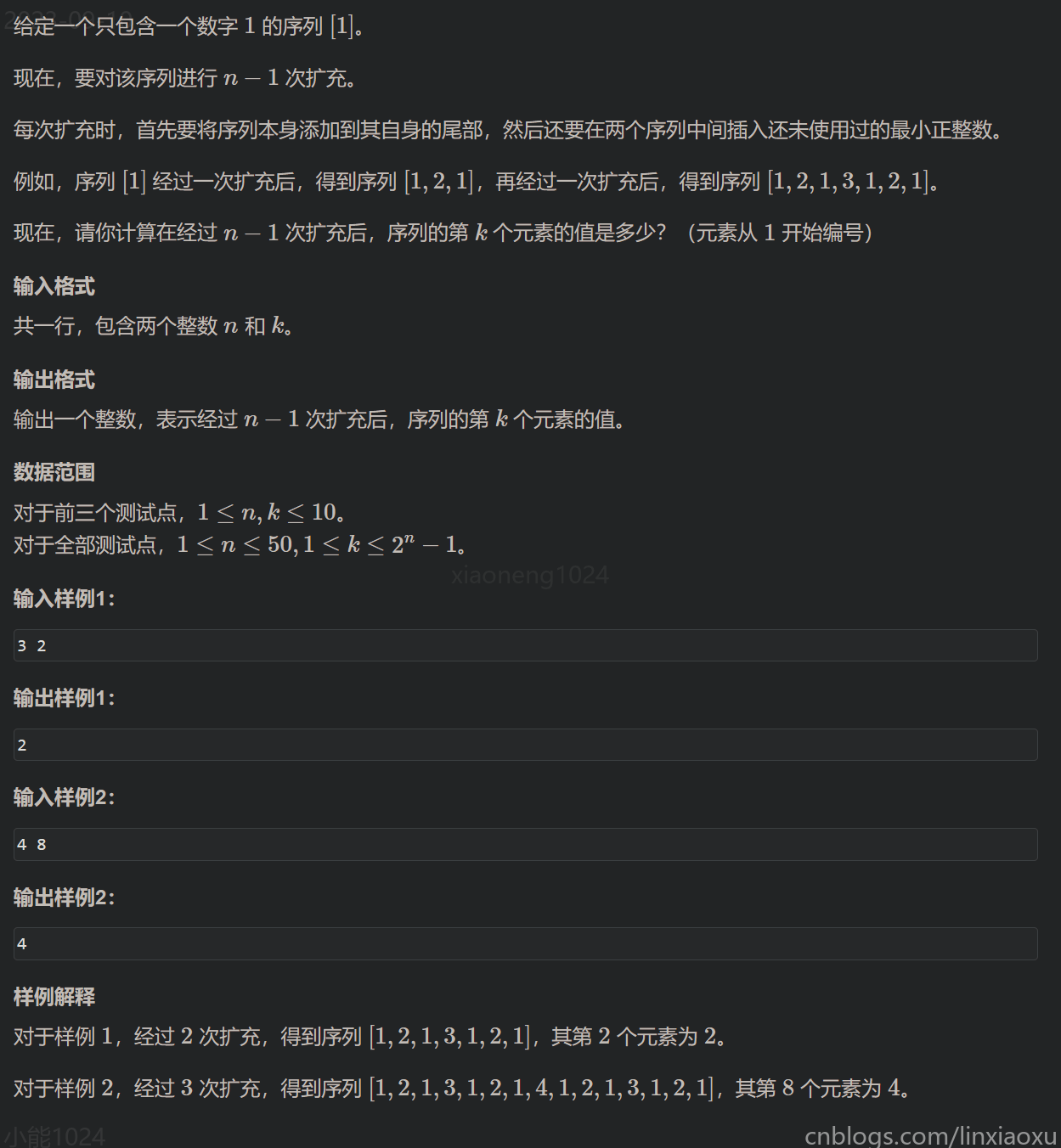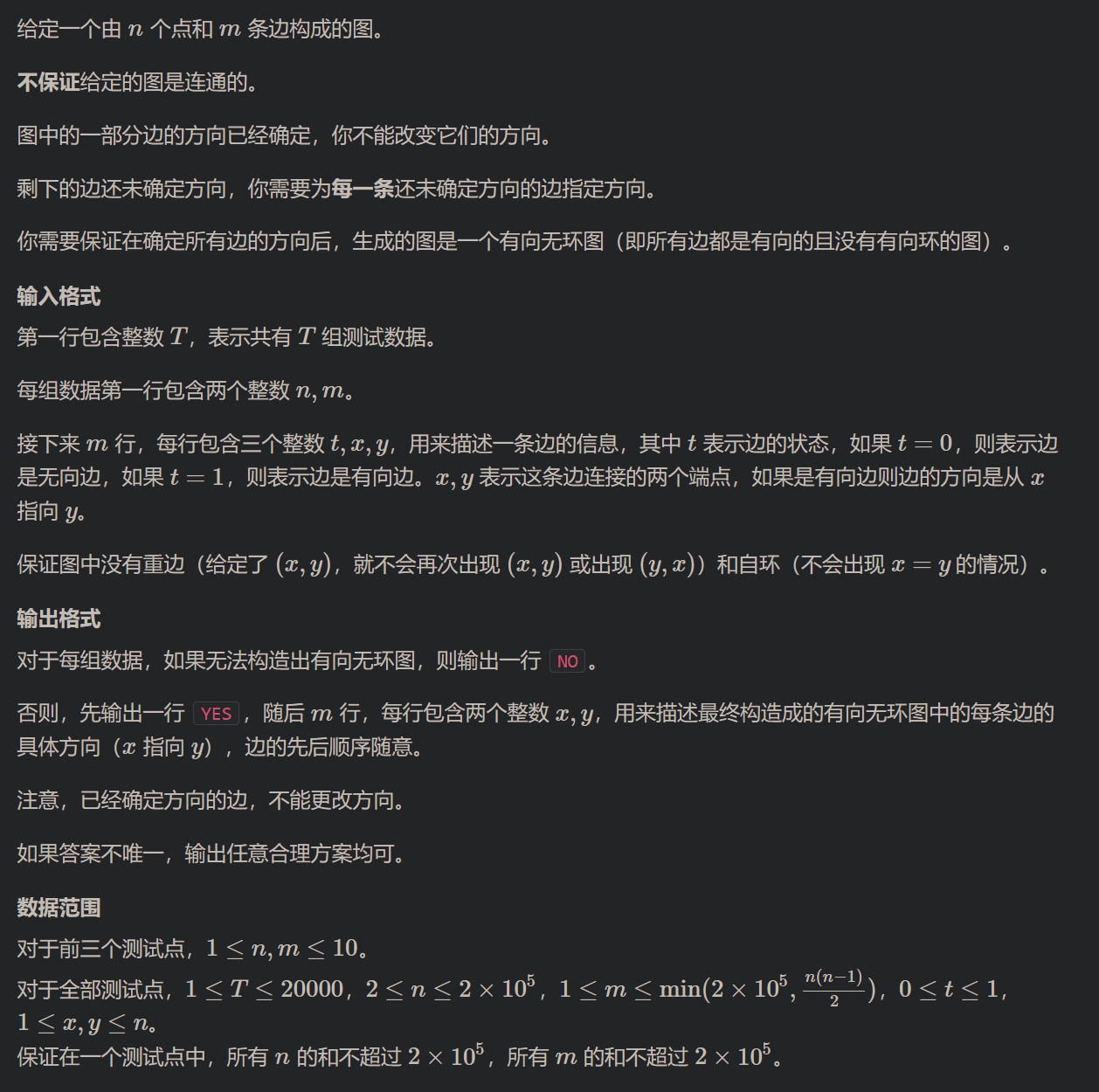C++ 算法竞赛、03 周赛篇 | AcWing 第4场周赛
AcWing 第4场周赛
3694 A还是B

简单题
#include <algorithm>
#include <cstring>
#include <iostream>
using namespace std;
int n;
int a, b;
int main() {
cin.tie(0);
char c;
cin >> n;
for (int i = 0; i < n; i++) {
cin >> c;
if (c == 'A')
a++;
else
b++;
}
if (a == b)
puts("T");
else if (a > b)
puts("A");
else
puts("B");
return 0;
}
3695 扩充序列

考查递归。可以发现最终序列除中点,左右两段都是相等的,可以依据这个特性来递归
超级长的序列缩小 \(log_2n\) 次,每次将 k 坐标映射到缩小的各个序列上,k肯定是其中一个序列的中点
#include <algorithm>
#include <cstring>
#include <iostream>
using namespace std;
typedef long long LL;
int n;
LL k;
LL counts = 1;
int find() {
LL mid = (counts + 1) / 2;
if (mid == k) return n + 1;
if (k > mid) k = k - mid;
n--;
counts = (counts - 1) / 2;
return find();
}
int main() {
cin >> n >> k;
for (int i = 1; i <= n; i++) counts = counts * 2 + 1;
int res = find();
cout << res;
return 0;
}
3696⭐构造有向无环图

考查拓扑序列
拓扑序列
理论知识 有向图的拓扑序列 | 第三章 图论 - 小能日记 - 博客园 (cnblogs.com)
d 数组存储每个点的入度,q 队列用于拓扑排序,以下是邻接表存储图的拓扑排序法(思路就是逐一删除点,再将入度为0的点加入队列)
- 若队尾
tt == n-1,意味着给定图的 \(n\) 个点均已入队,\(q[0]\) 到 \(q[n-1]\) 的排列就是一个拓扑序列 - 若队尾
tt != n-1,意味着只有 \(tt+1\) 个点入队,此时一定有环(没有入度为0的点),不是DAG(有向无环图 | 拓扑图)
int h[N], e[N], ne[N], idx;
int q[N];
bool topsort() {
int hh = 0, tt = -1;
for (int i = 1; i <= n; i++)
if (!d[i]) q[++tt] = i;
while (hh <= tt) {
int t = q[hh++];
for (int i = h[t]; ~i; i = ne[i]) {
int j = e[i];
if (--d[j] == 0) q[++tt] = j;
}
}
return tt == n - 1;
}
题解
- 先考虑有向边
- 有环:一定无解
- 无环:直接按照拓扑序列,从前往后添加边(不会影响该拓扑序列结果)
- 难点
- 稀疏图用邻接表存
- 测试点很多,数组很大,用memset可能超时;可以限制初始化字节数量减少时间,如 (n + 1) * 4 (4是int字节数)
- 每个测试点初始化不要漏掉 h(邻接表)、d(入度)、k(无向边个数)、idx(节点唯一编号)
- 根据拓扑序列映射各个点的前后位置,即 pos 数组,从而判断无向边 a,b 的先后次序
#include <algorithm>
#include <cstring>
#include <iostream>
using namespace std;
int const N = 2e5 + 10;
int h[N], e[N], ne[N], idx;
int d[N]; // 存入度
int pos[N]; // 存储每个点在拓扑排序的下标
int t;
int n, m, k; // k+1 存储无向边个数
// 存无向边
struct Edge {
int a, b;
} edges[N];
void add(int a, int b) {
e[idx] = b;
ne[idx] = h[a];
h[a] = idx++;
}
int q[N];
bool topsort() {
int hh = 0, tt = -1;
for (int i = 1; i <= n; i++)
if (!d[i]) q[++tt] = i;
while (hh <= tt) {
int t = q[hh++];
for (int i = h[t]; ~i; i = ne[i]) {
int j = e[i];
if (--d[j] == 0) q[++tt] = j;
}
}
return tt == n - 1;
}
int main() {
cin.tie(0);
cin >> t;
while (t--) {
cin >> n >> m;
memset(h, -1, (n + 1) * 4);
memset(d, 0, (n + 1) * 4);
k = idx = 0;
while (m--) {
int t, a, b;
cin >> t >> a >> b;
if (!t)
edges[k++] = {a, b};
else {
add(a, b);
d[b]++;
}
}
if (!topsort())
puts("NO");
else {
puts("YES");
for (int i = 1; i <= n; i++)
for (int j = h[i]; ~j; j = ne[j])
cout << i << " " << e[j] << endl;
for (int i = 0; i < n; i++) pos[q[i]] = i;
for (int i = 0; i < k; i++) {
int a = edges[i].a, b = edges[i].b;
if (pos[a] > pos[b]) swap(a, b);
cout << a << " " << b << endl;
}
}
}
return 0;
}

 标准的错误,经典的零分。考查递归、DAG、拓扑序列、邻接表
标准的错误,经典的零分。考查递归、DAG、拓扑序列、邻接表

 浙公网安备 33010602011771号
浙公网安备 33010602011771号